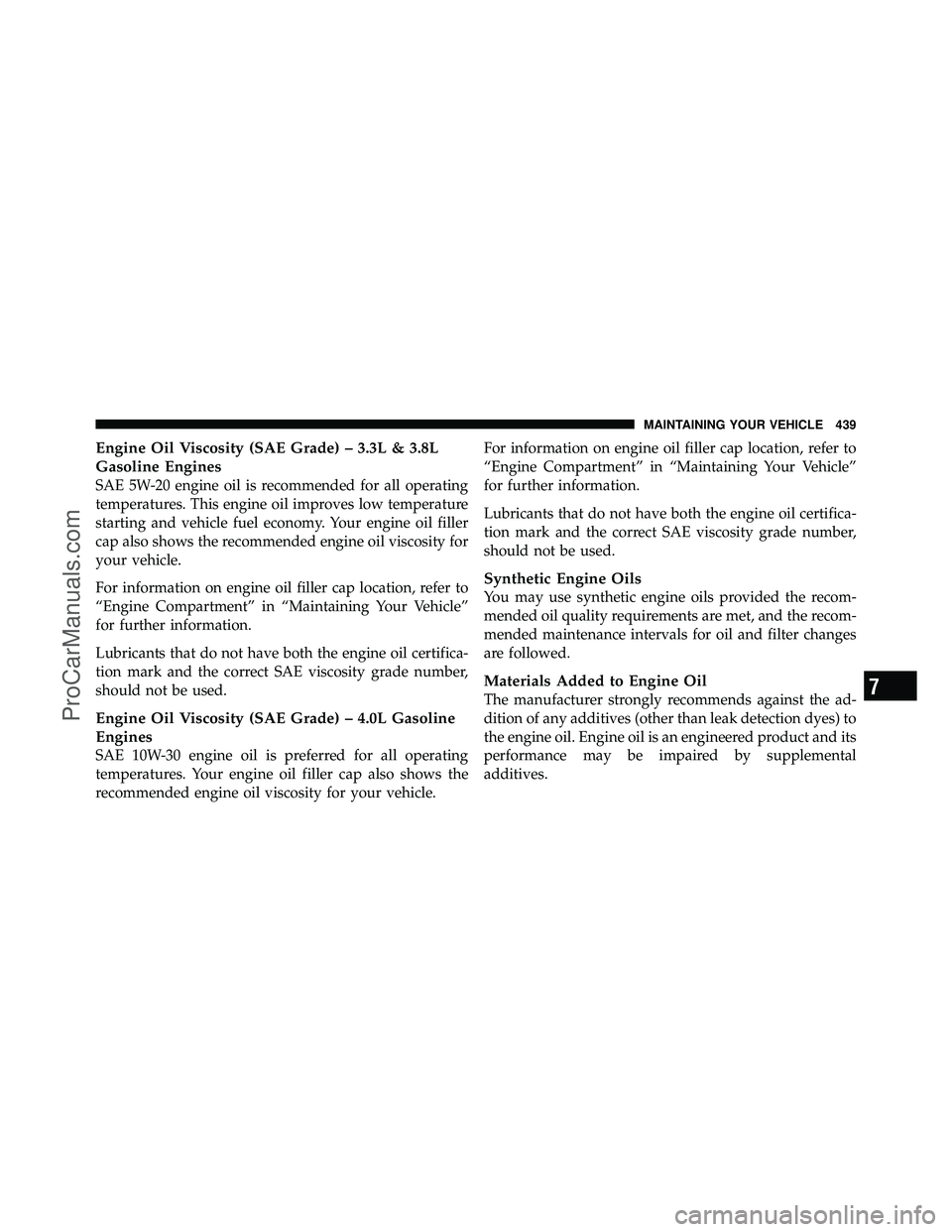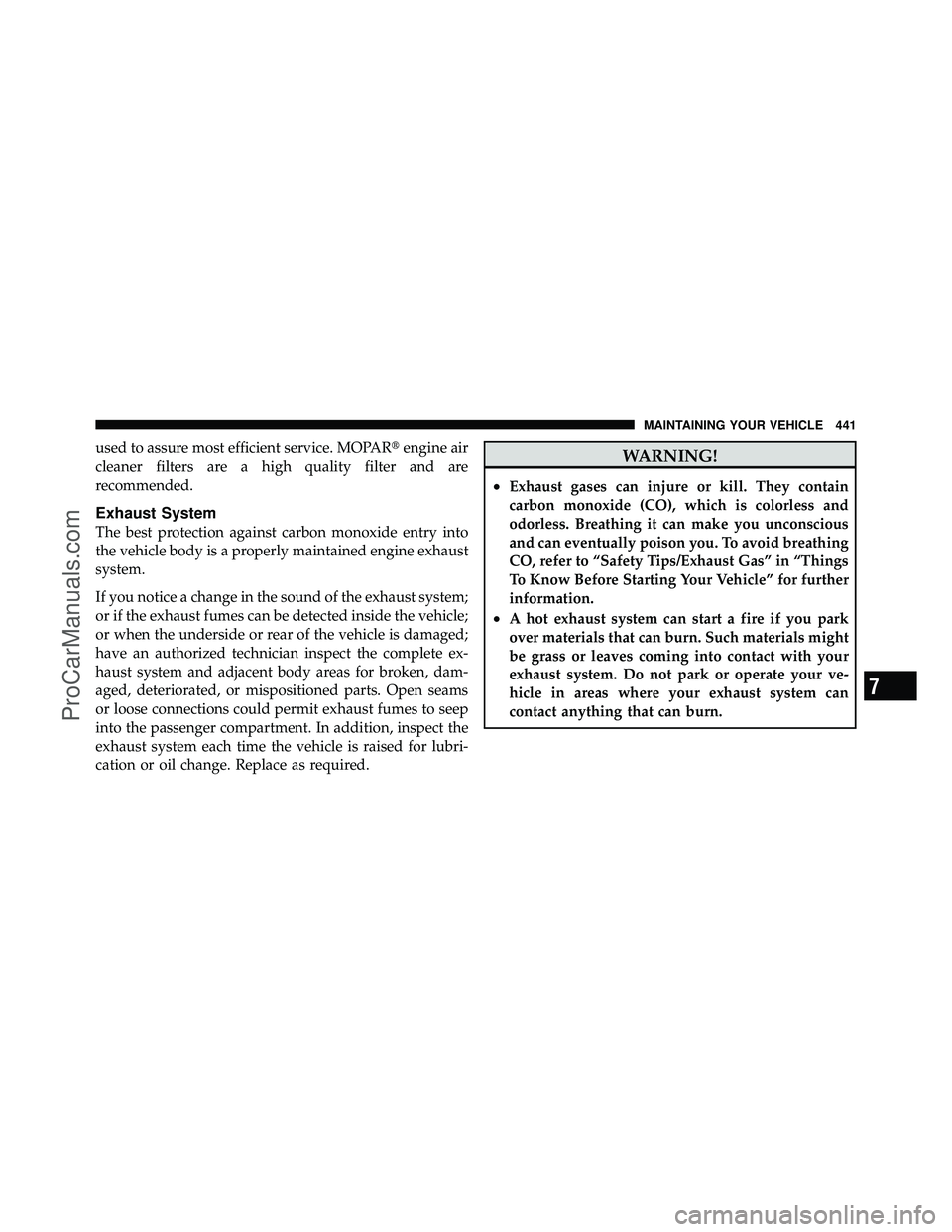Page 223 of 530
▫CD Player ......................... 296
� CD/DVD Disc Maintenance .............. 296
� Radio Operation And Cellular Phones ....... 297
� Climate Controls ...................... 297
▫ Manual Heating And Air Conditioning
System — If Equipped ................. 298
▫ Three-Zone Temperature Control —
If Equipped ........................ 302
▫ Rear Manual Climate Control —
If Equipped ........................ 304 ▫
Automatic Temperature Control (ATC) —
If Equipped ........................ 306
▫ Summer Operation ................... 314
▫ Winter Operation .................... 315
▫ Vacation/Storage .................... 315
▫ Window Fogging .................... 315
▫ Outside Air Intake ................... 315
▫ Operating Tips ...................... 316
▫ A/C Air Filter— If Equipped ............ 316
222 UNDERSTANDING YOUR INSTRUMENT PANEL
ProCarManuals.com
Page 317 of 530
Operating TipsA/C Air Filter— If Equipped
On vehicles equipped with Automatic Temperature Con-
trol (ATC), the climate control system filters out dust and
pollen from the air. Refer to “Air Conditioning” in
“Maintaining Your Vehicle” for filter replacement
instructions.
316 UNDERSTANDING YOUR INSTRUMENT PANEL
ProCarManuals.com
Page 430 of 530
MAINTAINING YOUR VEHICLE
CONTENTS
�Engine Compartment — 3.3/3.8L .......... 431
� Engine Compartment — 4.0L ............. 432
� Onboard Diagnostic System — OBD II ...... 433
▫ Loose Fuel Filler Cap Message ........... 433
� Emissions Inspection And Maintenance
Programs ............................ 434
� Replacement Parts ..................... 436
� Dealer Service ........................ 436 �
Maintenance Procedures ................. 436
▫ Engine Oil ......................... 437
▫ Engine Oil Filter ..................... 440
▫ Engine Air Cleaner Filter ............... 440
▫ Exhaust System ..................... 441
▫ Maintenance-Free Battery .............. 443
▫ Air Conditioner Maintenance ............ 444
▫ Body Lubrication .................... 447
▫ Windshield Wiper Blades ............... 447
7
ProCarManuals.com
Page 432 of 530
ENGINE COMPARTMENT — 3.3/3.8L
1 — Air Cleaner Filter7 — Engine Oil Fill
2 — Automatic Transmission Dipstick (3.3L Only) 8 — Engine Oil Dipstick
3 — Brake Fluid Reservoir 9 — Coolant Pressure Cap
4 — Battery 10 — Washer Fluid Reservoir
5 — Totally Integrated Power Module 11 — Power Steering Fluid Reservoir
6 — Engine Coolant Reservoir
7
MAINTAINING YOUR VEHICLE 431
ProCarManuals.com
Page 433 of 530
ENGINE COMPARTMENT — 4.0L
1 — Power Steering Fluid Reservoir7 — Engine Oil Dipstick
2 — Air Cleaner Filter 8 — Engine Oil Fill
3 — Brake Fluid Reservoir 9 — Coolant Pressure Cap
4 — Battery 10 — Washer Fluid Reservoir
5 — Totally Integrated Power Module
6 — Engine Coolant Reservoir
432 MAINTAINING YOUR VEHICLE
ProCarManuals.com
Page 440 of 530

Engine Oil Viscosity (SAE Grade) – 3.3L & 3.8L
Gasoline Engines
SAE 5W-20 engine oil is recommended for all operating
temperatures. This engine oil improves low temperature
starting and vehicle fuel economy. Your engine oil filler
cap also shows the recommended engine oil viscosity for
your vehicle.
For information on engine oil filler cap location, refer to
“Engine Compartment” in “Maintaining Your Vehicle”
for further information.
Lubricants that do not have both the engine oil certifica-
tion mark and the correct SAE viscosity grade number,
should not be used.
Engine Oil Viscosity (SAE Grade) – 4.0L Gasoline
Engines
SAE 10W-30 engine oil is preferred for all operating
temperatures. Your engine oil filler cap also shows the
recommended engine oil viscosity for your vehicle.For information on engine oil filler cap location, refer to
“Engine Compartment” in “Maintaining Your Vehicle”
for further information.
Lubricants that do not have both the engine oil certifica-
tion mark and the correct SAE viscosity grade number,
should not be used.
Synthetic Engine Oils
You may use synthetic engine oils provided the recom-
mended oil quality requirements are met, and the recom-
mended maintenance intervals for oil and filter changes
are followed.
Materials Added to Engine Oil
The manufacturer strongly recommends against the ad-
dition of any additives (other than leak detection dyes) to
the engine oil. Engine oil is an engineered product and its
performance may be impaired by supplemental
additives.7
MAINTAINING YOUR VEHICLE 439
ProCarManuals.com
Page 441 of 530

Disposing of Used Engine Oil and Oil Filters
Care should be taken in disposing of used engine oil and
oil filters from your vehicle. Used oil and oil filters,
indiscriminately discarded, can present a problem to the
environment. Contact your authorized dealer, service
station, or governmental agency for advice on how and
where used oil and oil filters can be safely discarded in
your area.
Engine Oil Filter
The engine oil filter should be replaced with a new filter
at every engine oil change.
Engine Oil Filter Selection
The manufacturer’s engines have a full-flow type oil
filter. Use a filter of this type for replacement. The quality
of replacement filters varies considerably. Only high
quality filters should be used to assure most efficient
service. MOPAR�engine oil filters are a high quality oil
filter and are recommended.
Engine Air Cleaner Filter
Refer to “Maintenance Schedule” for the proper mainte-
nance intervals.
WARNING!
The air induction system (air cleaner, hoses, etc.) can
provide a measure of protection in the case of engine
backfire. Do not remove the air induction system (air
cleaner, hoses, etc.) unless such removal is necessary
for repair or maintenance. Make sure that no one is
near the engine compartment before starting the
vehicle with the air induction system (air cleaner,
hoses, etc.) removed. Failure to do so can result in
serious personal injury.
Engine Air Cleaner Filter Selection
The quality of replacement engine air cleaner filters
varies considerably. Only high quality filters should be
440 MAINTAINING YOUR VEHICLE
ProCarManuals.com
Page 442 of 530

used to assure most efficient service. MOPAR�engine air
cleaner filters are a high quality filter and are
recommended.
Exhaust System
The best protection against carbon monoxide entry into
the vehicle body is a properly maintained engine exhaust
system.
If you notice a change in the sound of the exhaust system;
or if the exhaust fumes can be detected inside the vehicle;
or when the underside or rear of the vehicle is damaged;
have an authorized technician inspect the complete ex-
haust system and adjacent body areas for broken, dam-
aged, deteriorated, or mispositioned parts. Open seams
or loose connections could permit exhaust fumes to seep
into the passenger compartment. In addition, inspect the
exhaust system each time the vehicle is raised for lubri-
cation or oil change. Replace as required.
WARNING!
•Exhaust gases can injure or kill. They contain
carbon monoxide (CO), which is colorless and
odorless. Breathing it can make you unconscious
and can eventually poison you. To avoid breathing
CO, refer to “Safety Tips/Exhaust Gas” in “Things
To Know Before Starting Your Vehicle” for further
information.
•A hot exhaust system can start a fire if you park
over materials that can burn. Such materials might
be grass or leaves coming into contact with your
exhaust system. Do not park or operate your ve-
hicle in areas where your exhaust system can
contact anything that can burn.
7
MAINTAINING YOUR VEHICLE 441
ProCarManuals.com